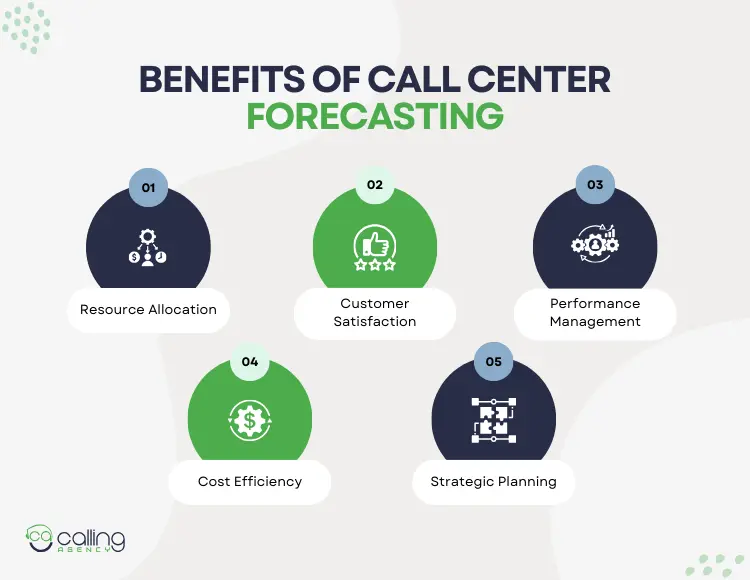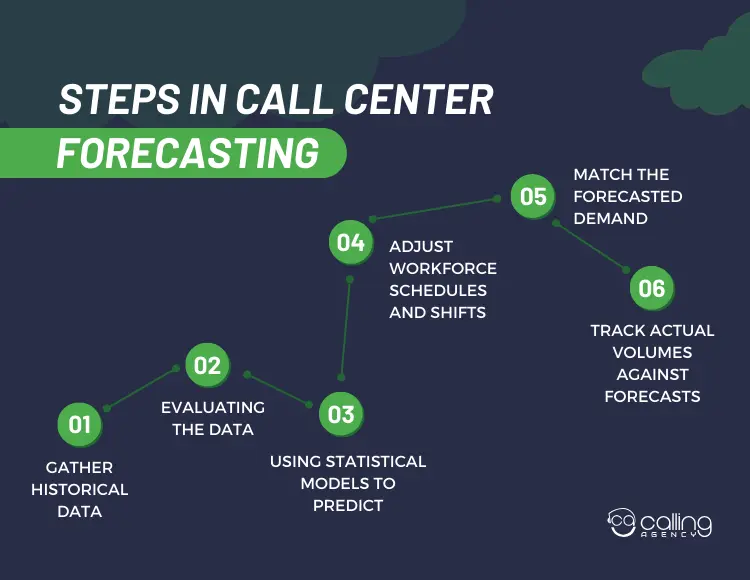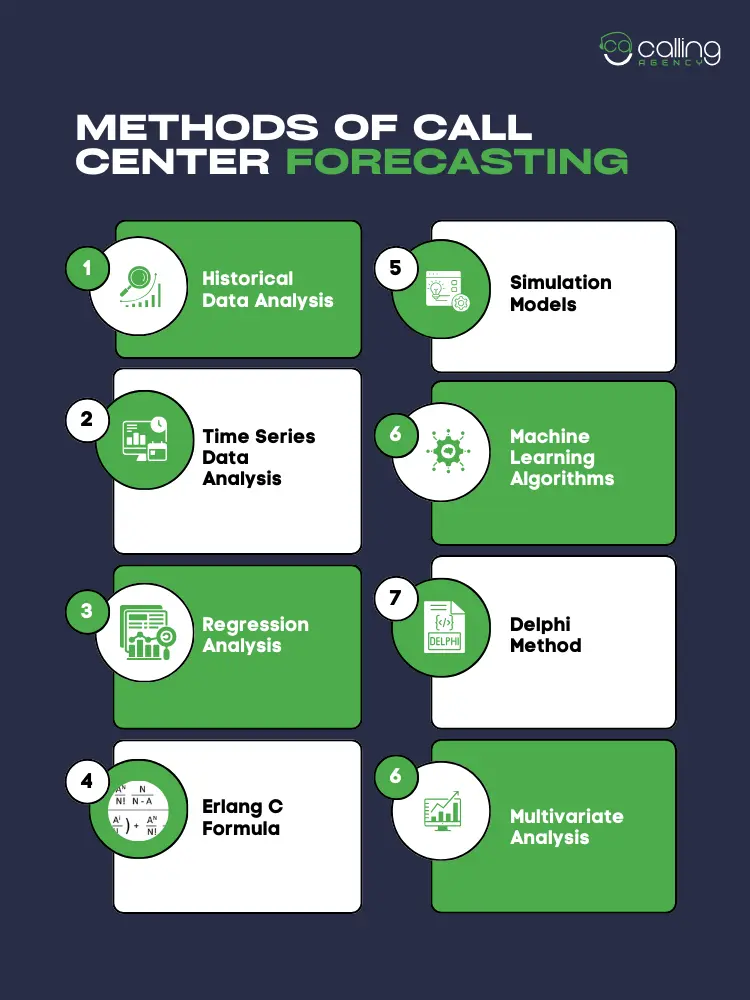Call center forecasting is about accurate predictions about the volume of calls your business will receive over a certain period. It provides the exact or probable number of agents you need to handle that call volume.
Forecasting in call centers involves analyzing historical data, identifying patterns, and utilizing various methods to predict the future demand for call center services.
If you own a call center, you must want to figure out the accurate number of calls you are about to receive in a period. Well, call volume forecast helps you with that.
Let’s know more about why it is necessary, the steps, and the methods of call center forecasting.
Why Call Center Forecasting is Important?
Forecasting call center services increases productivity and guarantees that your agency has enough employees to manage the number of calls. You can allocate the correct number of agents to handle incoming customer interactions at any given time.
Call center forecasting is the backbone of efficient call center operations. Now, take a look at why forecasting is important for call centers.

Accurate forecasting allows call centers to allocate their resources effectively. It helps in determining how many agents are needed at a given time. Resource allocation also helps to optimize staffing costs.
Customers prefer to avoid being put on hold. Call center forecasting allows you to maintain acceptable response times and improve service levels in a call center. By predicting call volumes, call centers can ensure enough agents are available to handle calls. Volume forecasting reduces customer wait times, increases loyalty, and improves customer satisfaction.
Forecasting aids in setting realistic performance goals for call center agents. Managers can set achievable targets and measure performance accurately by knowing what to expect.
Moreover, forecasting volumes helps call centers to minimize costs. Knowing the expected call volume can help to plan the budget for hiring, training, and infrastructure costs. Accurate call center forecasting enables you to reduce labor expenses and optimize operational expenses while maintaining the quality of customer service.
Over the long term, call center forecasting can aid in strategic planning. Trends in call volumes can provide insights into customer behavior, market conditions, and the impact of business decisions.
Steps In Call Center Forecasting
To ensure the effectiveness of call forecasting in a call center, you need to apply some specific steps. Call center forecasting and scheduling starts by identifying the relevant data sources that will provide the necessary information for accurate predictions.
You can identify these data by collaborating with IT teams, call center managers, and data analysts. After identifying relevant data sources, you can start the contact center forecasting. Now, let’s examine the six steps involved in call center forecasting.

1. Gather Historical Data
The first step in call center forecasting is gathering historical data. Historical data includes call volumes, handle times, and service levels from previous periods. They show the number of received calls and how your call center performed in the past.
The more data you have, the better your forecasts will be. This data can be collected from your call center software or other tracking tools. Call center forecasting tools seamlessly integrate with reliable data sources and provide call centers with access to correct information for generating accurate forecasts.
2. Evaluating The Data
Once you have gathered the data, you have to start evaluating it. Evaluating involves analyzing the data to identify patterns and trends and make informed decisions.
You can also examine external factors such as holidays, weather events, or other events and analyze if they impact call volume. Evaluate these data to refine your call center forecasting to anticipated changes in call volume due to specific events or circumstances.
For example, you might find that call volumes are higher at certain times of the day or certain days of the week. You could also observe patterns tied to specific seasons, such as increased call volumes during the holiday season.
3. Using Statistical Models To Predict Based On Data
After evaluating the data, the next step is to use statistical models to make predictions based on the data. Various statistical models, such as time series and regression analysis, can be used. These models use historical data to predict future call volumes.
Every statistical model has their strengths, limitations, and suitability. You need to select a model that aligns with the specific characteristics of your call center operations. You can choose the most appropriate approach for your needs by understanding the different call center forecasting models.
4. Adjust Workforce Schedules And Shifts
You can adjust workforce schedules and shifts based on accurate forecasting volumes. Workforce requirements ensure enough agents are available to handle the predicted call volumes.
It also helps adjust shift times, increase agent recruitment, or provide additional training to existing agents for managing increased call volumes.
5. Match The Forecasted Demand
Call center forecasting aims to match the forecasted demand as closely as possible. Monitor the call volumes and adjust the workforce schedules to match the forecasted demand.
For example, if the forecasting call volumes are higher than expected, implement overtime, shifting breaks, or reassign tasks to maintain service levels. The closer you match the forecasted demand, the more efficient your call center will be.
6. Continuously Tracking Actual Volumes Against Forecasts
Finally, tracking actual call volumes against the forecasts is essential. It allows you to see how accurate your forecasts are and make necessary adjustments. It also helps you refine your forecasting process and make it more accurate.
You can also track and calculate the difference between actual volumes and forecasts. Suppose you had forecasted 180 calls for a certain period. In that period, your call center has got 193 calls. So, the difference is:
((193 actual calls – 180 forecasted calls = 13) / 193 actual calls = .067) x 100 = 6.7%
Methods of Call Center Forecasting
There are several methods used for call center forecasting. These include historical data analysis, time series data analysis, regression analysis, Erlang C formula, simulation models, machine learning algorithms, Delphi method, and multivariate analysis.
Each of these methods has its strengths and weaknesses, and the best choice depends on the specific needs and circumstances of the call center. It’s often beneficial to use a combination of methods to achieve the most accurate forecasts.
Now, let’s learn more about these methods of call center forecasting.

Historical Data Analysis For Forecasting
Historical data analysis involves studying past data to identify patterns, relationships, and trends. With this study, you can predict future events or outcomes. In this method, historical information is a foundation for making informed predictions about what might happen next.
This method assumes that history will repeat itself and that the same patterns observed in the past will occur in the future.
For example, in finance, historical stock prices, trading volumes, and other market indicators are analyzed to forecast future market movements. Similarly, call center forecasters use historical data to predict future inbound telemarketing call patterns.
Time Series Data Analysis For Forecasting
Time series analysis involves using statistical methods to analyze data that are collected and recorded over time. It focuses on understanding trends and patterns within the data. It involves different models like ARIMA (AutoRegressive Integrated Moving Average) for forecasting.
This method can capture trends and patterns over time, making it useful for call center forecasting. It can compare data against past patterns, such as results from months ago. It makes the forecasts more accurate.
Regression Analysis For Forecasting
Regression analysis is a statistical process that estimates the relationships among variables. It can predict future call volumes based on historical call volumes, wait times, promotional events, or other factors.
This method starts by gathering historical data on call center metrics and potential influencing factors, like time, date, promotional activities, or seasonal trends. Then, you have to identify the factors that may affect call center metrics.
Regression analysis techniques, such as linear, multiple, or time series regression, predict call center metrics based on the selected variables. By employing this method, you can anticipate call volumes and staffing needs and optimize resources to meet customer demands efficiently.
Erlang C Formula
The Erlang C formula is a mathematical formula used in call center scheduling to calculate the number of agents needed to maintain a desired service level. It considers the arrival rate of calls, the average handle time, and the desired service level.
The Erlang C forecasting formula is complex. It involves using mathematical calculations to determine the optimal number of agents needed to meet the expected call volume while maintaining the desired service level.
Understanding and utilizing this formula allows call centers to balance service quality and operational costs by optimizing agent staffing based on anticipated call volumes and service level goals.
Simulation Models For Forecasting
Simulation models are computer-based models that mimic the operations of a call center to predict its performance under various scenarios. These models can predict how changes in variables like staffing levels or call arrival rates will affect service levels.
They offer a dynamic way to predict call center performance based on historical data and hypothetical scenarios. By testing hypothetical situations in a controlled environment, you can optimize staffing, scheduling, and other operational aspects to improve overall efficiency and customer service.
Machine Learning Algorithms For Forecasting
Machine learning algorithms use sophisticated computational techniques to predict call volumes, service demand, wait times, and other relevant metrics within a call center environment.
This algorithms utilize historical data to identify patterns, correlations, and trends that can be used to make accurate predictions about future call center performance.
These algorithms can learn from new data and improve their predictions over time. They allow you to optimize staffing levels, resource allocation, and operational strategies to meet service-level goals and improve customer satisfaction.
Delphi Method
The Delphi method involves using multiple rounds of questionnaires sent to a panel of experts to create a framework for forecasting. It gathers opinions and insights from a panel of experts or stakeholders to predict future call center trends, volumes, or other relevant metrics.
After each round, the collected responses are combined and then distributed among the group. The experts then revise their earlier answers based on the replies of other members of their panel. Through this process, the range of the responses will decrease, and the group will converge toward the “accurate” answer.
Multivariate Analysis For Forecasting
Multivariate analysis is a statistical technique used to analyze data that originates from more than one variable. It allows a comprehensive examination of their relationships and interactions.
Instead of focusing on just one variable at a time, the multivariate analysis considers how several factors together affect call center performance, such as call volumes, service times, agent efficiency, and more.
This sophisticated method can find complex patterns and relationships that simpler methods might miss. Multivariate Analysis allows you to make more accurate predictions and better-informed decisions regarding resource allocation, staffing, scheduling, and process optimization within the forecast call center.
The End Goal Of Call Center Forecasting
The end goal of call center forecasting is to ensure that the call center operates efficiently, with minimal wait times, optimal performance, and high customer satisfaction.
By accurately predicting call volumes, call centers can reduce wait times and improve service levels, leading to higher customer satisfaction. Satisfied customers are likelier to remain loyal and recommend the business to others.
Accurate forecasting also contributes to employee satisfaction. By ensuring appropriate staffing levels, employees are not overwhelmed with high call volumes, which leads to a better work environment.
Forecasting offers valuable insights that can guide strategic decision-making. For example, understanding peak call times can guide decisions about operating hours, staffing schedules, and even product offerings.
In the long run, effective call center forecasting contributes to business growth. Efficient operations, satisfied customers, and happy employees lead to a stronger, more successful business.
The end goal of call center forecasting goes beyond just predicting call volumes. It’s about using these predictions to drive decisions that improve customer satisfaction, improve operational efficiency, and contribute to business success.
Final Thought
Call center forecasting is an essential and ongoing process. It requires a combination of historical data analysis, statistical modelling, and expert judgment. Call centers can optimize operations and deliver excellent customer service by accurately predicting call volumes.
If you can assess the forecast of your call center, identify areas for improvement, and update your forecasting models constantly, you can maintain the effectiveness of your forecasts.
Forecasting in the call center allows you to satisfy customers and manage a successful call center.





